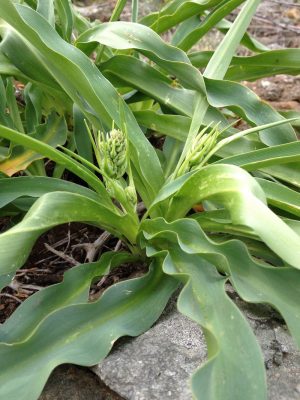
January is right smack in the middle of our rainy season and the world once again begins to put on its newest green robe. Here on the central coast our winter temperatures are mild, on average ranging from the mid 40’s to mid to the mid 50’s. The short days, cool nights and moisture stimulate grasses and some of the grass-like plants to begin a new cycle of vegetative growth. While hiking in the hills we begin to notice the green blush of new blades of grass. On open hillsides, in coastal scrub, chaparral or forest clearings you may notice the new leaves of one of our most interesting common bulbs also beginning to appear.
Similar to the grasses at first glance, these wild plants from the agave family are distinct. Their leaves are an inch or more wide, bold blue green with wavy margins emerging from often quite large dormant bulbs. If you look closely sometimes you can also see the fibrous fringe of the bulbs (technically a corm) outer tunic poking up above the soil.The drama for this plant begins at a slow roll. The leaf tips first appear in winter and the leaves emerge and elongate as the year gains momentum. By the end of winter the leaves have grown a foot or more in length and in spring the flower stem follows, a branched stem elongating up to a four feet or more in height. Profuse half-inch white six petal flowers open serially up the stem as the sun passes its zenith in the spring sky. The soap root bloom period can last from spring into summer. This is happy news for the native bumblebees. On a warm spring afternoon the bees become part of the show.
Soap root is a great plant for school gardens as it has significant historic interest. First Californians had many uses for the large fleshy bulb. It was lathered to create a natural soap, cut and thrown in fresh water pools to stun fish in and the fibrous outer hull was used to make brushes. Soap root thrives in a wide range of garden conditions. It provides a gratifying contrast to dark green shrubs such as monkeyflower and also works well in meadow plantings with needlegrass, checkerbloom, phacelia.